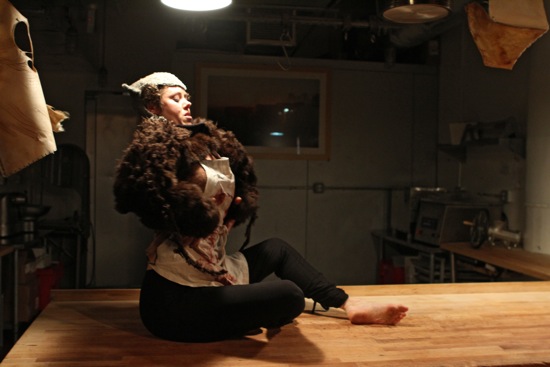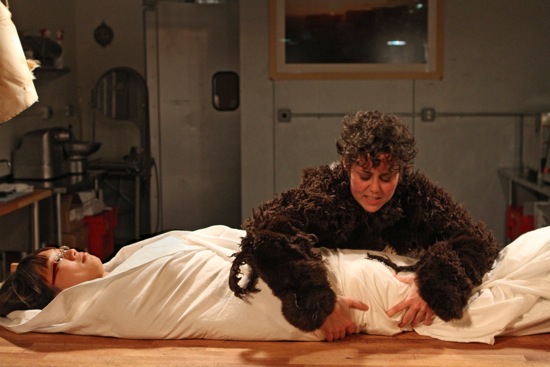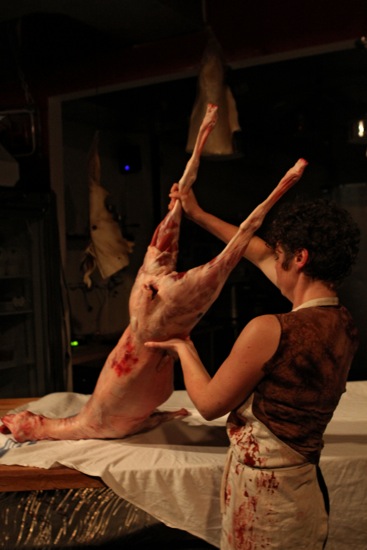
Carrie Ahern in her Borrowed Prey. Photo: Jule Lemberger
When writing about art with a message, critics tend to soft-pedal and back-pedal. Perhaps their hearts are with the messenger, yet they have reservations about the forms in which the ideas are delivered. Perhaps, for some, the message doesn’t come through strongly enough. There’s little doubt as to what Carrie Ahern wants to put across in in her provocative and deeply felt Borrowed Prey: If we eat animals, we should be willing to face what they endure between untroubled life in a pasture and becoming chops on a plate. She herself has experienced hunting game and learned how to kill chickens.
Ahern, an accomplished performer-choreographer, is showing her work (the first half of a projected diptych) at Dickson’s Farmstand Meats in the Chelsea Market, 75 Ninth Avenue, through May 13 (carrieahern.com). In the middle of the piece, she climbs on something in the narrow space behind the counter and writes two sentences on a big piece of butcher paper taped to the wall. One says, “Empathy is not generally seen as a useful tool.” For butchers in relation to the meat they sell, that’s probably true. But Ahern clearly feels a great deal of empathy for animals destined to be food, as does the brilliant autistic thinker Dr. Temple Grandin, who has redesigned numerous slaughterhouses to make them more humane (and whose words Aherne speaks during Borrowed Prey).
Grandin’s condition has made her sensitive to what cattle feel. She doesn’t like to be touched unless she initiates it. Physical pressure (like being wrapped in something) calms her. Loud sounds disturb her. Ahern, being a mover, wants to show us—as best she can—what animals respond to.
With the exception of the few people accommodated on VIP chairs, the spectators in Dickson’s market (20 is the limit) stand for the performance, moving around the close quarters when necessary or desirable. Ahern’s outfit (by Naoko Nagata) startlingly combines the butcher with the stock and challenges description: soft, non-descript black pants; a mottled brownish top; a shaggy, long-sleeved brown bolero jacket that looks as if it’s been cut from a cow’s pelt. On her head is a gray, faux-lambskin hood with a faint suggestion of ears. To this, add a blood-stained white apron.
Ahern climbs onto a large table that divides the narrow front part of the store from its larger workspace at the back. The table is topped by butcher block and can be wheeled to other positions. She moves both like a dancer warming up and a passive carcass. Lying on the table, she lets one leg hang limply over the edge, arches her back, then collapses. At one point, it’s as if someone is hauling her up by the buttocks. She spasms, folds herself into a bundle, and —half-hidden on the metal shelf under the table—trembles.
Throughout the hour-long piece, she finds ways to demonstrate how narrow a cow’s range of depth vision is, how it places its hooves, how four-legged animals groom themselves, scrabble for footing, sink down. After she has removed her hood, welcomed us, and brought up Grandin’s need to feel pressure, she begins to crawl among the spectators, rubbing against people’s legs, touching one watcher, standing up to lick another’s face (possibly someone she knows). She talks about the benign method of slaughtering chickens, while getting a volunteer (consulted quietly in advance) to lie on the table and be wrapped tightly in a length of unbleached muslin. Then—with the help of two nearby spectators—she lowers the young woman to the floor and drags her to the front of the shop. Swaddled like that, the woman resembles the paper-wrapped leg of lamb that Ahern gives away at the end of the performance, as well as the hand-stitched, hide and hair sculptures by lighting designer Jay Ryan and the choreographer that hang from the ceiling. (Ahern makes sure that “Amy” is all right and back among friends before continuing the work).
Borrowed Prey is most powerful when it is most direct in terms of the complex bonding of consumer and consumed. Two sections affected me less, or, fell short of what they seemed to intend. One occurs just after Ahern has performed her initial sequence on the table. Anne Hege’s very effective music begins with a high voice calling, and Ahern begins to dance. Her little turned-out steps could pass for bourrées, even though her body eventually starts to jiggle and sag. Finally, she collapses under the shop’s painting of cows in a sunset field. I couldn’t figure this out. Is she afraid we’ll forget she’s a dancer? Is she trying to forge a connection between ballet’s vision of the creaturely world and the gritty reality?
After Ahern has fetched a dressed lamb from the shop’s refrigerator and carried it through the shop so everyone can see it up close, she washes her hands and head at the sink and contemplates the six-inch knife she’s about to use (here the music switches to “Knife Dance” by New Prosthetics). The lamb is already missing one leg. She wants to convey, I believe, that even a dead animal must be treated with respect, and that butchery can be conceived as a ritual. But somehow, this sequence seems a little heavy-handed, especially when she places the knife blade against her own ankle and holds it there for a few seconds. We get the point. In the same way, it seems almost corny for her to hold a leg of lamb against her own leg, comparing them (maybe it’s the timing that’s at fault). She also licks the knife quite a lot—as if to show that the killing tool itself doesn’t inspire fear in animals.
It’s more engrossing—and somehow more moving—to see her use the knife on the lamb’s body. She moves with care and a dancerly ease, shifting angles as she slices the animal’s remaining leg off, wraps it in paper and tapes it. She carefully frees the small kidneys and lays the hanging tongue beside something else retrieved from the cavity. These too she wraps and bestows on favored spectators.
Just before she tackles the lamb, she polls the spectators about the other statement she wrote earlier: “The greatest of ethological sins is anthropomorphism.” Is she guilty or innocent of this? She stands there wide-eyed, waiting. After a long silence, the woman standing behind me says quietly “guilty.” No one else speaks.
The matter is more complicated. Ahern isn’t attributing to her prey the nuanced human feelings that pet owners commonly ascribe to their animals (she missed me, he likes my husband better). She knows that what keeps her awake at night wouldn’t trouble a sheep, and vice versa. As Grandin found, given the right conditions, cattle don’t experience terror as they approach slaughter. Yet in very sensitively and skillfully absorbing and physicalizing the animal’s responses, isn’t Ahern making the animal seem humanized simply because a human is portraying it? (She must know that there’s no easy answer to that.)
Her final image brings the ambiguity into sharp focus. She doesn’t rise and bow as we clap and get up to leave. She’s sitting on a stool at the rear of the workspace, holding the dead, carved-up lamb in her lap and looking down at it. Madonna and Child. The Lamb of God. Life as death. If you look behind the obvious sentimentality of the picture, it can keep you awake and thinking hard for some time.



Oh lamb of god who taketh away the sins of the world…it’s interesting to me that Ahern centers on a lamb, a powerful symbol in Christian and Muslim ritual. I admire the honesty of this review; I wouldn’t attend the performance if my life depended on it; the vivid description is quite enough for me.
Is this Temple Grandin and perhaps Ann Carlson carried well beyond their natural conclusion?
Ahern is a sadist, pure and simple. No complexity, no ambiguity.